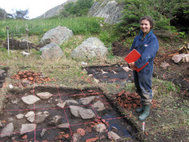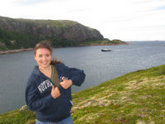Rebecca Mayus, Summer 2013 Internship at the Smithsonian Institution’s Arctic Studies Center
This summer I had the opportunity to work as an intern with Dr. William Fitzhugh, an archaeologist and director of the Smithsonian

Institution’s Arctic Studies Center. I accompanied Dr. Fitzhugh on his field season to the Lower North Shore of Quebec, where we joined a group of divers from the University of Montreal and conducted land and underwater excavations at Hare Harbor, a late 16th/early 17th century Basque whaling and cod fishing station.
In preparation for the work in Canada, I spent several weeks in Washington DC, working at the National Museum of Natural History. There, I studied previous field reports about the site and began to compile these reports into a monograph. Having familiarized myself with the Hare Harbor project, I set off to meet Dr. Fitzhugh in Newfoundland, where we boarded the 50-foot longliner Pitsiulak, a Smithsonian research vessel which would serve as our home and base of operations for the next month. I had no experience with archeological fieldwork prior to this internship. For that matter, I had no prior experience with life at sea, and so it would be a bit of an understatement to say that the field season in Canada was a new experience. However, as soon as we set sail for Quebec and a pod of white-sided dolphins came to race alongside the Pitsiulak I knew I was in for an incredible summer.
It would be difficult to exaggerate the extent to which I enjoyed my time aboard the Pitsiulak. The site at which we worked was incredibly beautiful, and my shipmates were only too happy to introduce me to all the things which I, having grown up far from any coastline, had been missing all my life: Newfoundland folk music, fresh cod and lobster straight from the ocean, the art of intricate knot-tying and rope-twining, and bakeapples, the bright orange subarctic berries which form the centerpiece of what quite possibly may be the world’s best pies.

But the most rewarding aspect of the trip was the archaeology itself. As one who hopes to pursue anthropological study into graduate school, I found the training I received alongside Dr. Fitzhugh to be invaluable. Not only was I involved with digging at the sight, but I was also able to assist in the analysis of finds by learning techniques for plotting stratigraphy and artifact distribution. Our finds allowed for increased understanding of seasonal Basque occupations at Hare Harbor. Moreover, Hare Harbor has revealed evidence of an Inuit presence, and our work contributed to an elucidation of what appears to be peaceful Basque and Inuit cohabitation. As we worked to excavate a hearth feature at the site, I felt a constant sense of excitement and anticipation: a sense of being able to discover the stories of those who had visited the area before me and thereby share in and become a part of their history. For this reason I was more than happy to sift through handfuls of dirt looking for the rusted shells of iron nails and broken bits of pottery, to carefully plot the positions of terra-cotta roof tiles, and to painstakingly uncover by hand minuscule bird bones, the unexpectedly hardy remnants of a dinner 300 years past. These experiences will not only aid me as I continue my studies in anthropology but will always stand out as exceptional opportunities to contribute to a truly rewarding cause: the exploration and interpretation of a part of human history.